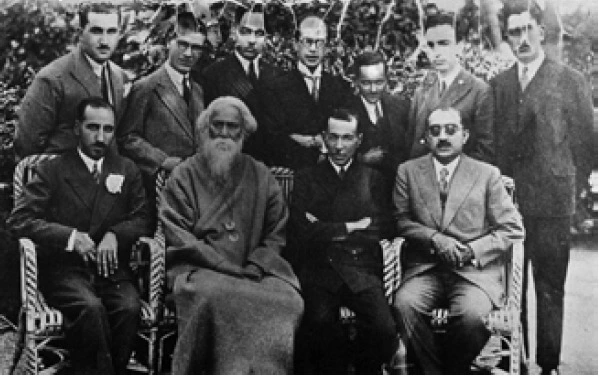(Photo: Seated from right: Dīnshāh Īrānī, Muḥammad Taqī Bahār, Tagore, ‘Alī Dashtī. Standing from right: Asadī, Rashīd, ‘Abbās Iqbāl, Sa‘īd Nafīsī, Ustād Falsafī, Muḥammad Sa‘īdī, Maykada.Source: 1351 مجله موسیقی خرداد Majala-yi Mūsīqī (Khurdād 1351 A.Hsh./1972), 8
تاگور در کنار ادیبان ایرانی در ایران 1932, نشسته از راست: دینشاه ایرانی ، محمد تقی بهار ، تاگور ، علی دشتی. , ایستاده از راست: اسدی ، رشید ، عباس اقبال ، سعید نفیسی ، استاد فلسفی ، محمد سعیدی ، میکادا
Tagore knew about Iran only in literature. This was despite his profound familiarity with classical Persian poetry,
He had yet to visit Iran.

Given his interest in ancient Iran, Zoroastrianism, his admiration for its literature and Ḥāfiẓ, and his wish to find common ground in Islam and Hinduism, he eagerly accepted the invitation of Reza Shah to visit Persia.*
Despite his advanced age and ill health on April 11, 1932 Tagore flew to Karachi. From there he travelled to the port of Busher in the Persian Gulf, He was accompanied by a small entourage of Bengali intellectuals, (including the poet Amiya Kumar Chakravarty and writer Kedar Nath Chattopadhyay),112
The governor of Busher port greeted Tagore with these verses from the Iranian Sufi poet Sa‘di:
ایو الناس جهان جای تن آسایی نیست … مرد دانا به جهان داشتن ارزانی نیست
خفتگان را چه خبر زمزمه مرغ سحر … حیوان را خبر ازعالم انسانی نیست113

On Zoroastrianism
Tagore devoted Chapter 5 of his book ‘Religion of Man’ to ancient Iranian religions with respect and admirartion for Zoroastrianism.
Zoroaster; ‘The greatest of all the pioneer prophets who showed the path of freedom from the multiplicity of shrines’
Zoroaster offered ‘the freedom to man, the freedom of moral choice, the freedom from the blind obedience to unmeaning injunctions.’
Tagore’s view about Zarathustra, the Iranian prophet108

‘Zarathustra spiritualized the meaning of sacrifice, which in former days consisted of external ritualism entailing bloodshed.’109
(Rabindranath Tagore)
Statue of Zoroaster-Chicago University
‘Zarathustra spiritualized the meaning of sacrifice, which in former days consisted of external ritualism entailing bloodshed.109
Rabindranath Tagore
His travelogue; پرشیا ‘Parashya’
Tagore wrote a travelogue in Bengali about his journey to Iran. It is called ‘Parashye’ (Persia), It is ‘much more than a diary or a travelogue by an acute observer of cultures.’
‘This travelogue is the closest thing to a real history among Tagore’s writings based not just on philosophical musings, but fairly on solid empirical research.’114 (unfortunately a complete copy of Parashye could not be located for this research).
Tagore was charmed by the hospitality lavished upon him by the Iranians.
He said that “There was absolutely no occasion,” when the Persians made him “feel that they belonged another society or religious community.”119
While in Iran, Reza Shah of Iran endowed a professorship of Persian Studies at Tagore’s University (Visva-Bharati), The pre-Islamic Persian literature scholar, استاد ابراهیم پورداوود Professor Ibrāhīm Pūrdavūd was appointed to be the first occupant of its chair.118
“For the Persians, my identity has another special feature. I am Indo- Aryan . . . I have a blood relationship with them. 120
Rabindaranath Tagore
Meditating beside the tomb of Hafez
When meditating beside the tomb of Ḥafiẓ, Tagore recalled his hosts that Ḥafiẓ was one of a very few Persian poets of his day to have mentioned Bengal in poetry:
شکّرشکن شوند همه طوطیان هند … زین قند پارسی که به بنگاله میرود122

Like and share the story
Rabindranath Tagore’s trip to Iran, 1932
Tweet
Dr Leonard Lewisohn notes that ‘although Persian Sufi ideas constitute a significant feature of Tagore’s philosophical and mystical thought, these aspects are generally disregarded by critics of his writings*.
With no formal education, Tagore received the 1913 literary Nobel Prize for his spiritual poems. In this series, we take a look at his upbringing and his views.
In this series we will know more about the Rabindranath Tagore family, get familiar with his pedagogy, and the widespread Persian culture of Bengal before the division into East and West Pakistan, and the role of Persian Islam in the Indian reform of Brahmo Samja.
- More on Tagore:
- Hafez and Rabindranath Tagore
- Persian; the language of Bengal until British arrvide in 19th century
- Persian sufism and Indian reform; Ram Mouhan Roy (1772-1833)
- Imam Ali’s followers in a princely family; Rabindranath Tagore
- From avoiding schools to winning the literary Nobel prize
- Calcutta (19th century); the rendevous of Persian poets
- Rabindranath Tagore’s trip to Shiraz to visit Hafez (1932)
- Why did Tagore renounced his Knighthood
- Hungry Stones; an excerpt of a short story by Rabindranath Tagore
- Shiraz 1932; Tagore meditating beside the tomb of Hafez
Suggested readings and references:
Special thanks to Dr Leonard Lewisohn from the University of Exeter for his research that contributed to the main body of this series adaptation. Additional materials were sourced from Professor Emeritus Irfan Habib’s, and Dr Beatrice Teissier’s publications. Sentences showing an asterisk (*) above may be traced to the provided research materials containing over 145 Parsian and English academic references.
- Rabindranath Tagore’s Syncretistic Philosophy and the Persian Sufi Tradition, Leonard Lewisohn, University of Exeter, 2017, Published by Penn State University Press
- TEXTS FROM THE PERSIAN IN LATE EIGHTEENTH-CENTURY INDIA AND BRITAIN: CULTURE OR CONSTRUCT? Beatrice Teissier, Oriental Institute, Oxford, 2009, Published by Taylor & Francis, Ltd.
- Jallianwala Bagh Massacre, Irfan Habib, 2019, Published by Social Scientist
